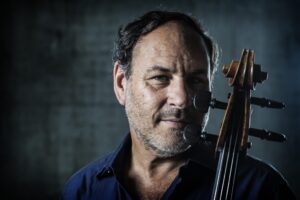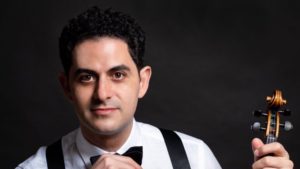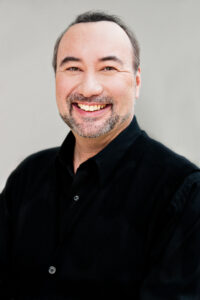Passion Meets Folklore
Be immersed in the lushness and heart of Rachmaninoff and Smetana, featuring cellist Gary Hoffman

Featured Artists

Gary Hoffman made his debut at the Wigmore Hall in London at the age of fifteen, quickly followed by New York. At the age of twenty-two he became the youngest faculty appointee in the history of Indiana University School of Music. After winning the Premier Grand Prix of the Rostropovich International Competition in Paris in 1986, he embarked on an international career, appearing with the world’s most noted orchestras, in major recital and chamber music series and at prestigious festivals.
“We play the way we are.” Those few words have rarely sounded so true as in the case of Gary Hoffman. In front of audiences or of his students at the Queen Elisabeth of Belgium Music Chapel and the most prestigious American campuses, he does not come to deliver a message. He stands before us, not to please us. He plays out of necessity, because music and life are one. It seems so simple in a world awash with images, slogans and attitudes.
He plays to be himself. The rules impose themselves naturally: to master the instrument’s technique and enter step by step into the universe of a work. But to what end? If it is to seek perfection, Gary Hoffman is happy to miss his turn… But if his playing awakens the beauty of a phrase and he can share its light with others, the artist is fulfilled. In his eyes, the cult of efficiency and volume never takes precedence over the expression of beauty, which has nurtured him since his youth, when he listened to the greatest musicians and discovered cinema and painting, his other passions. To build a philosophy of life through art: is there any nobler ambition?

Winner of a 2009 Avery Fisher Career Grant, Arnaud Sussmann has distinguished himself with his unique sound, bravura, and profound musicianship. Minnesota’s Pioneer Press writes, “Sussmann has an old-school sound reminiscent of vintage recordings by Jascha Heifetz or Fritz Kreisler, a rare combination of sweet and smooth that can hypnotize a listener.”
Mr. Sussmann has recently appeared as a soloist with the Mariinsky Orchestra under Valery Gergiev, and the Vancouver, and New World Symphonies. As a chamber musician, he has performed at the Tel Aviv Museum, London’s Wigmore Hall, Lincoln Center, and the White Nights Festival in Saint Petersburg. He has also given concerts at the Caramoor, Music@Menlo, La Jolla SummerFest, Mainly Mozart, and Seattle Chamber Music festivals, collaborating with many of today’s leading artists including Itzhak Perlman, Shmuel Ashkenasi, Wu Han, David Finckel, and Jan Vogler.
Sussmann is Artistic Director of the Chamber Music Society of Palm Beach, Co-Director of Music@Menlo’s International Program, and teaches at Stony Brook University.

Pianist Jon Kimura Parker is the Creative Partner of the Minnesota Orchestra, Artistic Director of the Honens International Piano Competition and Artistic Advisor of the Orcas Island Chamber Music Festival. This season he performs in New York at Lincoln Center, Toronto with the Galilee Chamber Orchestra, Chicago with the Montrose Trio, as well as in Boston, Phoenix, Kansas City, Dallas, Quebec, Portland, and Minneapolis.
He has collaborated with legendary rock drummer Stewart Copeland in Off the Score, tango pianist Pablo Ziegler, singer Bobby McFerrin, violinist Cho-Liang Lin, and mezzo-soprano Susan Graham, A committed educator, he is Professor of Piano at the Shepherd School of Music at Rice University. His Whole Notes series is available on Amazon Prime, and he is a featured Tonebase artist.
Winner of the Gold Medal at the 1984 Leeds International Piano Competition, Parker is an Officer of The Order of Canada and has received Honorary Doctorates from the University of British Columbia and the Royal Conservatory of Music, Toronto.
Jon Kimura Parker studied with Edward Parker and Keiko Parker, Lee Kum-Sing at the Vancouver Academy of Music and the University of British Columbia, Marek Jablonski at the Banff Centre, and Adele Marcus at The Juilliard School.
Concert Playlist
About The Music

Following the disastrous premiere of his Symphony No. 1 in 1897, Sergei Rachmaninoff (1873-1943) barely composed for three years. He finally sought help from the psychiatrist Nikolai Dahl in 1900, and after months of hypnotherapy he regained his confidence. He channeled his newfound energy into the Piano Concerto No. 2, a work he completed in 1901, with the score dedicated to his therapist.
Rachmaninoff’s next project was the Cello Sonata in G Minor, a work that benefited from his renewed self-assurance. The piano writing came out unusually rich and virtuosic for a cello sonata, as if Rachmaninoff still had traces of concerto writing in his head and hands. He performed the premiere himself, a month after the redemptive debut of the Second Piano Concerto.
The Cello Sonata begins with a pensive introduction, the rising phrases hanging like questions. The body of the movement strikes up a flowing Allegro moderato tempo, with the cello delivering the main theme over an arpeggiated accompaniment punctuated by forceful, staccato chords. The pace slows to an expressive Moderato tempo for the second theme, a bittersweet motive centered on D-major that the piano introduces alone before the cello rejoins.
Next an Allegro scherzando movement works through a range of ideas in C-minor; some of them come off as “joking” in a manner that befits the scherzando heading, while others are deadly serious. For the Andante movement, the piano again unveils the melody alone, and there is a strong tension between minor and major from the very first measure, rehashing an argument that flares up throughout this unflinching sonata.
The principal theme of the Allegro mosso finale is a swashbuckling, G-major affair in a triplet tempo, but that music must compete with a showstopper of a secondary theme—a passionate, Romantic outpouring that ranks among Rachmaninoff’s most affecting melodies.

A generation before Dvořák brought his native sounds out into the world, Bedřich Smetana (1824-1884) pioneered the idea of a Czech musical identity. Born in a small Bohemian castle town, Smetana came into his own as a composer at a time when his country was pushing back against Austrian political and cultural influence. Long before he composed the Czech-language operas that were his greatest legacy, he tried and failed at the career model of the touring piano virtuoso. As a fallback he established himself in Prague, opening a music institute and composing such works as the Piano Trio in G Minor (Op. 15), completed and debuted in 1855. Poor reviews of the trio from Prague’s critics (contrasted against a favorable response from Franz Liszt) factored into Smetana’s decision to take a teaching job in Sweden for the next seven years.
Composed after Smetana’s eldest daughter died of scarlet fever, the Piano Trio is unabashed in its intense feelings, setting all three movements in the key of G-minor. A fervent theme, first issued by unaccompanied violin, sets a brooding tone for the opening movement in a Moderato assai tempo. The faster middle movement functions as a scherzo, and its tempo instruction of “Fast but not agitated” ensures a lighter tone even within the dark key area of G-minor. Two sections that Smetana labeled Alternativo provide contrasting perspectives. The fiery finale interrupts itself with several tranquil interludes that waft in like sweet memories, while another passage mimics the grave strides of a funeral march, emphasizing the personal heartache that fueled this trio.
CMSPB does not discriminate on the basis of race, gender, creed, ethnicity, religion, sexual orientation, age or disability and we are a 501(c)(3) nonprofit organization.
Site maintained by Teller | © 2020-2022 Chamber Music Society of Palm Beach | All rights reserved.
